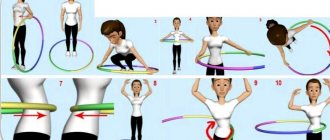A calorie deficit is a method of losing weight that involves reducing the consumption of high-calorie foods and increasing the calorie expenditure by the human body. When creating a calorie deficit (CD), it is very important to follow certain rules to prevent metabolic disorders and force the body to lose weight naturally. Protein elements, fats and carbohydrates coming from food that the body could not convert into energy resources are deposited in the form of fatty deposits in the subcutaneous layers. Therefore, for stable weight loss, you need to find a nutritional deficiency in which the body will be forced to independently look for energy sources. Only in this case will his focus be on breaking down fat deposits in order to release the necessary energy.
The correct process of losing weight with the help of recreational therapy is to gradually reduce weight, equal to no more than 1% per week of the initial weight. Only this approach will ensure stable weight loss and will not allow the lost kilograms to return. Weight will decrease due to a decrease in the amount of fat deposits, and not due to loss of water. The weight of muscle fibers remains unchanged. So, for weight loss, it is recommended to use a calorie deficit of 10 to 20%, depending on the desired rate of weight loss. After achieving your goal, you can begin to reduce the deficit by gradually increasing the daily intake of high-calorie foods: we’ll talk in more detail about how to calculate the calorie deficit and how to apply all this in your own life in this review.
Reasons for the lack of effectiveness of creating a recreation center
In order for weight loss using the calorie deficit formula to be successful, it is necessary to create it without stress for the entire body.
It is important to understand that under stress, the body automatically goes into protection mode and slows down all metabolic processes and calorie consumption decreases significantly, so weight stops losing.
It will be much easier to go through the process of losing weight if you include a couple of workouts a week in your usual lifestyle and increase your daily physical activity by 10,000 steps.
Thanks to this approach, the daily diet can be increased to 250 kcal. Increasing physical activity and using strength training will help you lose weight properly and, when losing weight, prevent sagging skin.
Exit from the calorie diet
To avoid weight gain when switching from a diet to a more familiar diet, you should follow some rules:
- continue to practice the habits developed during the diet - drink enough water, prepare food in certain ways, exercise;
- then adhere to fractional meals of 5-6 meals a day;
- every week you can add 100 kcal to your previous diet, while tracking the numbers on the scales;
- to maintain weight, you should continue to count calories and adhere to your daily norm, calculated earlier;
- eat fatty sweets, fast food and other prohibited foods no more than 1-2 times a week.
By adhering to simple rules, you can forever remain at the weight that is comfortable. During the diet, the body will get used to relying on a small amount of calories, and the stomach will shrink so much that it will not be able to accommodate the previous volumes of food.
MORE ABOUT: Endometriosis and endometritis -
DC calculation method
An accurate calculation of a calorie deficit is to minus 10-20% from the daily calorie intake on support.
Video
You can calculate your maintenance calorie intake by adding up your daily activity, metabolic rate, and training intensity. When a deficit is created, carbohydrate intake is reduced by 30-35, and then by 50 grams.
It is important to know that in order to lose weight and create a deficit of 500 kcal, it is necessary to reduce the consumption of not only carbohydrates, but also fats.
The optimal reduction in the daily diet is considered to be a decrease in the amount of food consumed by 250 kcal and an increase in physical activity by the same amount of kcal. This results in a deficit of 500 kcal. So, in order to obtain the required level of deficit for smooth and comfortable weight loss, you first need to make additional calculations. Namely, calculate your individual daily calorie intake for weight loss.
Reviews
Women who have lost weight by counting calories say that such a system is quite simple, but effective. Among the main advantages, they highlight the ability to independently decide what to eat and what to refuse.
The main thing is to ensure that the number of calories you consume does not go beyond the norm. With a competent approach (when the number of calories is reduced by 20% of the norm), weight loss occurs quite slowly, but the result lasts for a long time.
On average, you can lose no more than 2-3 kg in a month. This value is optimal and safe for the body.
Calculation of daily calorie intake for weight loss
There are two ways to determine the basal metabolic rate (BMR): using the Harris Benedict formula or the Muffin-Jeor formula. Let's consider both options.
Video
Calculation formula according to Harris Benedict
The updated version of this formula looks like this:
- For women: GV = 447.593 + (9.247 x weight in kg) + (3.098 x height in cm) – (4.330 x age in years);
- For men: GV = 88.362 + (13.97 x weight in kg) + (4.797 x height in cm) – (5.677 x age in years).
Small deviations from the calculated norm of 212 kcal per day for men and 200 kcal for women are possible. This is an indicator of the energy necessary for the human body to maintain vital processes at rest, without additional activity.
Video
Muffin-Jeor Formula
For girls and women: GV = 9.99 x weight in kg + 6.25 x height in cm – 4.92 x age in years – 161.
For the male half, this formula looks slightly different: GV = 9.99 x weight in kg + 6.25 x height in cm – 4.92 x age in years +5.
After the ALE has been determined, it is necessary to determine the indicator of QAL, that is, the coefficient of vital activity, which is determined by the following indicators:
- low activity level (sedentary work) = 1.2;
- presence of slight physical activity (at least 10,000 steps per day) = 1.3;
- average activity level = 1.4;
- intense activity level = 1.5;
- high vital activity = 1.75;
- participation in professional sports = 1.9.
Then we multiply the indicators of VT and KAJ, as a result we get the value of support calories. After this, you can create a calorie deficit to lose weight or a surplus to increase body weight if there is a lack of it. Underweight often occurs in people professionally involved in bodybuilding and other types of sports activities, so the concept of excess is more relevant specifically for this contingent.
The Truth is: You Can Lose Weight on a Calorie Surplus
"If someone gained more muscle than they lost fat, they gained weight and that means they were in a calorie surplus." That's what people think. But this opinion is based on an inherently flawed premise.
Energy balance is a mathematical principle.
Changes in energy intake/expenditure = Daily intake - daily expenditure
We can calculate calorie deficit/surplus based on body change data. Someone who gained 1.5 kg of muscle and lost 0.5 kg of fat would have a calorie deficit of 1810 kcal. But this is physics.
Let's go further. You can lose weight if you are overweight. This happens when you gain muscle fast enough to use up the energy your body gets from fat loss.
However, based on simple calculations, you should gain muscle about 5.2 times faster than you lose fat. In other words, you should gain 2.5 kg of muscle for every 0.5 kg of fat lost. In real life, the body simply will not allow this to happen. This simply cannot happen.
For an athlete, it is possible to lose fat while in excess. This often happens to women.
For example, look at the data below. She lost 1.3 pounds (0.6 kg) of fat and gained 6.8 pounds (3.3 kg) of lean muscle mass. This put her in a positive energy balance - her diet was 170 kcal higher.
A real example of calculating a calorie deficit
Let’s calculate together the calorie deficit for a forty-year-old woman, 165 cm tall and weighing 65 kg, who works as an accountant and dreams of losing weight. According to the updated Harris Benedict formula, the total energy content is 1387 kcal, without taking into account motor activity and physical exertion. The QAF indicator in this case will be equal to 1.2 or 1.3 if this woman takes at least 10,000 steps daily. Next, we multiply TBV and KAFA: 1387 kcal x 1.3 = 1803 kcal, which is equal to the calorie support indicator, i.e., if you follow a diet equal to the daily consumption of 1803 kcal, this woman will constantly remain in the same shape, neither lose weight nor gain weight .
Let's create a calorie deficit for weight loss: 1803 kcal - 15% = 1533 kcal - the calorie level required for weight loss in a specific example. We calculate the calorie deficit: 1803 - 1533 = 270 kcal. By increasing the activity rate of her movements and introducing several trips a week to the fitness center into this person’s usual lifestyle, the calorie deficit will increase by another 200-250 kcal, thus, the total calorie deficit for weight loss will already be 500 kcal. Fats/proteins/carbohydrates = 55/105/154 = 1533 kcal.
Video
In order to calculate the amount of daily BZHU norm, you must use the following formulas:
- The amount of protein element a person needs depends on the level of activity and total energy consumption. Therefore, you can calculate the protein norm if you know your body weight using the formula: 0.8 - 1.8 grams * kg body weight. If your excess weight is less than 10 kg, then for optimal weight loss it is enough to consume 100 g of protein per day.
- The amount of fat is calculated by the formula: 0.8 - 1 * kg of body weight, the rest comes from carbohydrates.
It is important to remember that 1 gram of protein equals 4 kcal, just like carbohydrates, but 1 gram of fat equals 9 kcal.
In the process of losing weight, the recommended amount of protein consumed should not exceed 1 gram per kg of weight, but you should not eat more than 30 grams of protein in one meal, otherwise this may lead to its deposition in fatty layers. It is recommended to eat no more than 120 grams of protein per day for people leading a normal lifestyle. A lack of protein is not as bad as an excess of it.
Video
In order to create a calorie deficit correctly, it is recommended to calculate calorie intake for two weeks on support. After the maintenance caloric intake has been at the same level for several days and the weight has not changed, you can begin to create a deficit for sustainable weight loss.
Kinds
There are 3 types of low-calorie diets.
Each of them differs in the characteristics of its chemical composition. Type I (main type):
- total energy content: 1200–1400 kcal;
- proteins: 100–110 g;
- fats: 80–90 g;
- carbohydrates: 120–150 g.
Type II (moderately limited type):
- total energy content: 1100–1200 kcal;
- proteins: 70-80 g;
- fats: 60-70 g;
- carbohydrates: 70-80 g.
Type III (maximum limited type):
- total energy content: 650–1100 kcal;
- proteins: 40-50 g;
- fats: 30-40 g;
- carbohydrates: 50-70 g.
The second category is optimal for reducing weight parameters. The third is the strictest, it is prescribed for obesity and the need to rapidly lose weight.
Calorie Deficit Calculator
Avoid the weight loss math and complicated understanding of what a calorie deficit is by using an online calorie deficit calculator:
| Your age | |
| Floor: | Your weight in kg. |
| Your physical activity |
For the most effective and stable process of losing weight, you should increase your activity and expend more energy than it comes from food, and also make at least 80% of your diet exclusively from healthy food. It will be much easier to do this if you measure the weight of all food products used for cooking every day and record the results in a special program for Android Fatsecret.
Myth No. 10. Cutting calories makes you hungry, so it doesn't work in the long term.
– We eat a lot when we are bored.
– We eat a lot from large containers.
– We eat a lot when people around us eat a lot.
– We eat a lot if we don’t control our calories.
– We eat a lot when we eat too fast.
– We eat a lot when we are worried.
So unless you are trying to achieve extremely low fat levels, you can usually control your appetite by choosing an appropriate diet.
If you've been suppressing your hunger for too long or eating only low-calorie foods, you may lose your appetite completely. Even a moderate diet can upset the balance between ghrelin, the hunger hormone, and leptin, the satiety hormone. Lack of hunger indicates that these hormones are out of balance and is one of the signs of a caloric deficiency.
If you feel sleepy instead of active, it may be due to a lack of calories. It can also be due to a deficiency of important minerals, so forget about losing weight and focus on your health.
Sometimes constipation is a sign that your food doesn't have enough calories.
Contraindications for the diet
Losing weight by reducing calorie intake has virtually no restrictions. It is prohibited for children and adolescents to resort to this method of weight loss, and it is also not advisable for pregnant and lactating women.
In this case, the caloric content of the diet can be calculated so as not to go beyond the limits and not gain excess weight, but not to reduce the number of incoming kilocalories.
For gastrointestinal diseases, varying degrees of diabetes and some other abnormalities, you should start drawing up a menu after consultation with your doctor. Elderly people should also be careful.
MORE ABOUT: How to prepare and drink oat decoction: step-by-step recipes and secrets of use
Calorie diet for weight loss
With a sedentary lifestyle, the daily energy intake is 1500 kcal. The more active your life, the more you can eat. On average, a person should consume at least 1200 calories per day.
When creating a diet for weight loss, it should be remembered that a serious lack of calories causes stress in the body, and instead of losing weight, it begins to store fat.
MORE ABOUT: What is uterine cavity aspirate? How does the taking take place?
If you want to lose weight, your daily calorie intake should differ from your daily intake by no more than 500 kcal. This difference will help you quickly lose weight without harm to your body.











